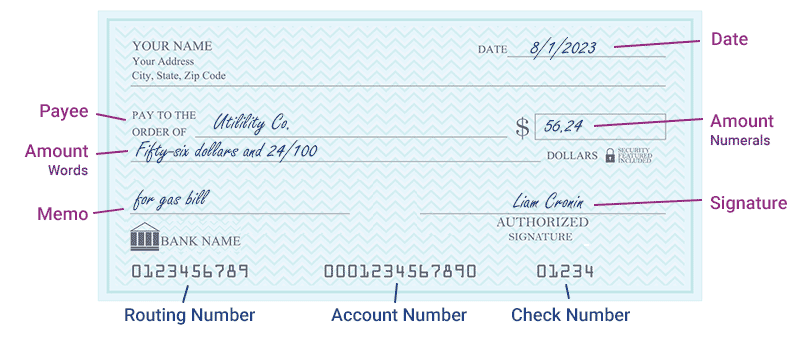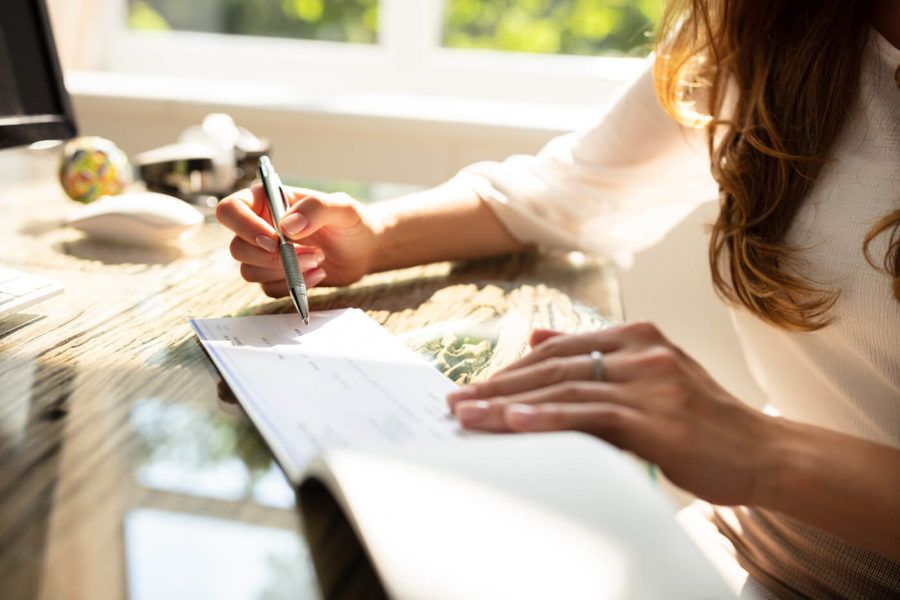In this article:
In the age of digital transactions, writing a check may be a lost art. However, you still may need to write a check to make certain payments, such as a down payment on a house or a monthly rent payment.
Writing a check is pretty simple, once you understand how to do it. You can write a check by filling out the various fields on the check, including the date, recipient and dollar amount. Here, we offer a step-by-step guide on how to write a check.

Step-by-Step Guide to Writing a Check
Once you're aware of what appears on a check, writing one is pretty easy. Here are seven steps to follow for writing a check.
1. Write Down the Date
In the upper right-hand corner of the check, you'll see a line where you need to jot down the date that you're writing the check. Write out the month, followed by the day and year. For instance, if you wrote a check on the first day of August in 2023, you'd write August 1, 2023.
It's worth noting that it generally is legal to write a check with a future date, known as a postdated check. However, a financial institution might still process a postdated check before the date you've put on the check. Laws in some states might require a financial institution to wait to process the check if you've given them "reasonable notice," according to the Consumer Financial Protection Bureau.
2. Put Down the Recipient's Name
Below and to the left of the line for the date, you'll spot the words "Pay to the order of," followed by a line. On that line, you'll put down the name of the organization or person you're making a payment to.
For example, if you're writing a check for rent, you'd fill in the name of your apartment's owner or manager. So, if your landlord is World's Best Apartment Company, you'd write that name on the "Pay to the order of" line.
3. Fill in the Dollar Amount
To the right of the "Pay to the order of" line is a dollar sign and a box. In that box, you'll put the amount of the check in dollars and cents. If you're writing a rent check to World's Best Apartment Company for $1,000, you'd put these numerals in the box: 1,000.00. There's no need to write the $ symbol before the amount since it's already printed on the check.
4. Spell Out the Dollar Amount
After you've filled in the box with digits, you need to spell out the dollar amount of the check in the same way that you'd say it out loud. You'll do this on the line below the "Pay to the order of" line.
To make out a check for your $126.50 internet bill, for example, you'd write:
One hundred twenty-six dollars and 50/100 cents
Notice that the number 26, when spelled out, is hyphenated. That's because all larger numbers should be hyphenated when you're completing this line. In addition, you don't need to put the word "and" after "One hundred," and you don't need to spell out the cents. Instead of spelling out the cents, use a fraction to indicate the amount (50/100 for 50 cents, for example).
If the check is for an amount with no cents, such as $100, write out the word "One hundred" followed by the fraction 00/100.
Remember to draw a line after the written-out amount of the check to fill out that space. This helps prevent someone from altering the amount of the check after you've written it.
5. Complete the Memo Line
In the lower left-hand corner of the check is a line, known as a memo line, where you can briefly describe the purpose of the check. For instance, if you're writing your rent check to World's Best Apartment Company, you can put the word "rent" on that line.
By the way, you don't have to write anything on the memo line. This information is for your reference; financial institutions don't pay attention to what shows up on the memo line.
6. Sign the Check
In the bottom right-hand corner of the check is a line where you can put your signature in cursive writing. Generally, a bank or credit union won't accept a check that hasn't been signed. Therefore, the recipient typically wouldn't be able to deposit or cash it.
Your signature should match your name as it's printed on the check. For instance, if your name appears on the check as James S. Smith, you should sign it that way.
7. Record the Check in Your Checkbook
Be sure to record the check, including the recipient and the amount, in your checkbook register. The register helps you keep track of transactions and then match that information to the monthly statement issued by your financial institution.
Find Digital Checking Accounts
How to Keep Your Checks Secure
While checks are generally secure, you can follow these practices to help ensure your check isn't involved in some form of wrongdoing:
- Use a pen to write a check. If you don't fill out the check in pen, someone could erase what's on the check and jot down new information. Ideally, the pen should be a black gel pen. Ink from a black gel pen is tough to remove.
- Don't hand anyone a blank check. Giving someone a check that isn't filled out enables them to put down whatever information they want, including a recipient's name and a dollar amount.
- Avoid blank spaces. In particular, the line where the dollar amount of the check is written out should include a line that you draw after the amount. This might stop someone from changing the amount after you've written the check.
- Order checks from a reputable company. To make sure your checks are legitimate, it's wise to order them through your bank or credit union or from a well-known brand.
- Keep checks in a safe place. Put your checkbook in a secure spot at home, and avoid carrying a checkbook with you when you're away from home.
- Monitor checks. After you've written a check, keep an eye on your account to make sure the check was deposited or cashed. If you notice the check hasn't been deposited or cashed in a reasonable amount of time, consider placing a "stop payment" on the check. A stop payment typically comes with a fee.
- Be careful when mailing checks. If you're mailing a check, consider dropping it off at a post office or handing it to a mail carrier rather than leaving it in an unattended mailbox. This reduces the risk of the check being stolen.
- Shred checks instead of tossing them in the trash. Doing so can help protect your personal data and keep your checks from being stolen.
How Do You Cash a Check?
Someone has written a check to you. Now what? How do you cash a check?
You should be able to cash or deposit the check at a branch of your bank or credit union, at the financial institution that issued the check, at an ATM or with a mobile app. You also may be able to cash the check at a store, such as a supermarket or big-box retailer. If you do this in person, you may need to show an ID, such as a driver's license.
Before you cash a check, you'll need to sign, or endorse, the back of the check. Your signature may go in an area that says, "Endorse Here." That may be followed by another line that states, "Do not write, stamp, or sign below this line."
If you deposit a check using a mobile device, you're supposed to follow specific instructions based on federal regulations. Below your signature in the endorsement area, you should write "For Mobile Deposit Only." Even though you may see a box designating that you're making a mobile deposit, checking this box doesn't fulfill federal requirements.
What happens if you don't sign the check or don't write "For Mobile Deposit Only" below your signature? Your financial institution might reject the deposit.
Alternatives to Writing a Check
These days, consumers enjoy a number of alternatives to writing a check. Among them are:
- Making an online payment through your bank or credit union account.
- Using a payment app like Zelle, Venmo, PayPal or Cash App to send peer-to-peer payments by phone.
- Getting a cashier's check. A customer uses their own money to buy this kind of check. But when it's being processed, a cashier's check is backed by a financial institution's own funds rather than a customer's funds. Therefore, it's considered more secure than a personal check or money order.
- Purchasing a money order. Banks, credit unions, grocery stores and convenience stores are among the places where you can pay a small fee to buy a money order. This method doesn't require you to have a checking account.
- Relying on a debit card. With a debit card attached to a bank account, you can make a payment in person or online, just as you would with a credit card.
- Turning to a credit card. If you don't want to write a check or don't have a checking account, you might opt for a credit card. Keep in mind, though, that unless you pay off your credit balance in full every month, you'll likely rack up interest charges. Also, the recipient may charge a fee if you pay via credit card instead of a different method.
The Bottom Line
Paper checks may be dying, but they're not dead yet. Therefore, it's smart to know how to write a check if you've got a checking account at a bank or credit union. Although you might normally carry out transactions online, via debit card or through apps, you never know when someone might insist on receiving a payment in the form of a paper check.


